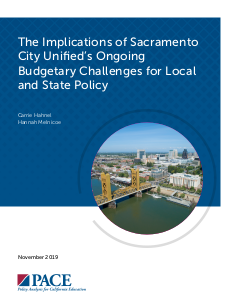The Implications of Sacramento City Unified's Ongoing Budgetary Challenges for Local and State Policy
Year of publication:
November 2019

Sacramento City Unified School District (SCUSD), California’s thirteenth largest school district, faces a looming deficit and must make significant budget adjustments to avoid state intervention. This case study explores how the district reached this point, how its finances compare with other districts in Sacramento County, and what the implications are for students, particularly those with the greatest needs. It finds that:
- Many of SCUSD’s troubles can be linked to broader issues affecting districts across the state, including declining enrollment, increasing special education costs, and increasing pension payments.
- The district’s instability, past budgeting practices, and tense labor-management relations have created a rocky foundation upon which the district must address its current budget situation.
- As compared with neighboring districts, SCUSD spends far more on health care and a smaller share of its budget on salaries for pupil support personnel, teachers, classified instructional staff, and office staff. Many stakeholders agree that the greatest fiscal challenge in SCUSD is the high cost of health care.
These challenges are making it harder to retain talented staff and teachers, limiting opportunities for the highest-need students, widening inequities, and reducing public commitment to public education. Our study of SCUSD offers considerations for policymakers and lessons that may apply to other districts facing a similarly troubling combination of statewide cost pressures, tense labor-management relations, and high health care costs. These lessons learned include:
- Unaffordable teacher benefits, however well intentioned, will impact district budgets if not addressed.
- Tense labor-management relations jeopardize financial stability and public confidence.
- Additional county or state authority to take corrective action may be needed to address the root causes of fiscal distress.
- Districts face real and unavoidable cost increases, and although money alone cannot address all the root causes of financial distress, more funding is an important part of the solution.
SCUSD’s fiscal crisis cannot be solved overnight. Even with major fixes now, the district will be paying off liabilities for decades to come. What leaders in SCUSD can do now is stabilize the situation, steer a course toward future sustainability and success, and restore public confidence.
This report is part of a two-case series looking at the implications of district budgetary challenges in Marin County and Sacramento City Unified School District.




